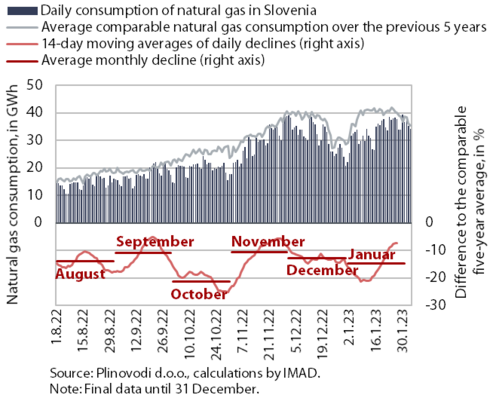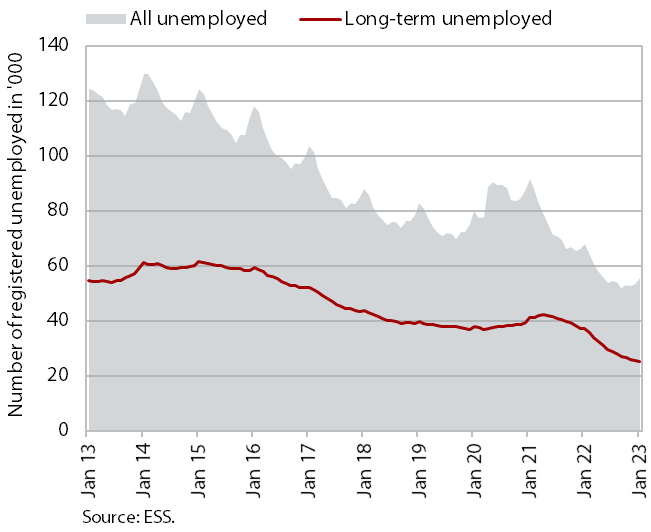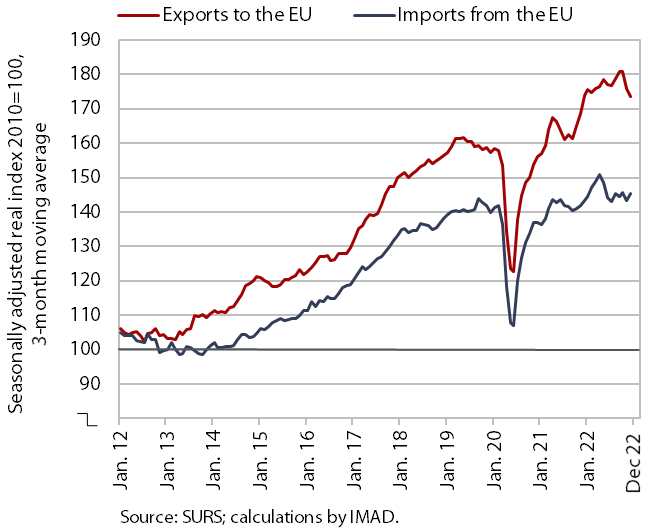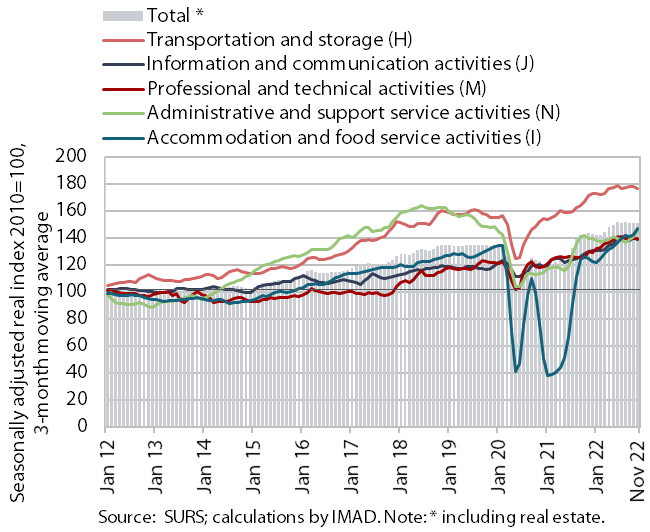Charts of the Week
Charts of the week from 30 January to 3 February 2023: natural gas consumption, number of registered unemployed, trade in goods and turnover in market services
In January, the decline in natural gas consumption was slightly higher than in the previous two months. On average, consumption from 1 August 2022 was 14% lower than the average of the last five years. According to the seasonally adjusted data, the number of unemployed fell in January and was almost one-fifth lower year-on-year. The number of long-term unemployed is also declining, reflecting high labour shortage. Trade with EU Member States declined in the fourth quarter of last year and companies expect a modest volume of new orders given the high level of uncertainty in the international environment. After two months of decline, real turnover in market services increased slightly in November and was also higher year-on-year.
Natural gas consumption, February 2023

In the last two months of 2022, natural gas consumption was slightly more than 10% lower than in the same months of previous years and in January 2023 the gap with previous years widened to 15%. Part of industry reacted to the high gas prices by reducing production output and thus consumption. Government measures also contributed to a more rational use of gas. According to Eurostat, the decline in gas consumption between August and November 2022 compared to the previous five-year period was even greater at EU level – about 20% lower on average and even more than 40% lower in the Scandinavian and Baltic countries. By mid-November, EU Member States were able to almost completely fill their gas storage capacities, but since then the storage level has been gradually declining. According to preliminary data, gas consumption in Slovenia from 1 August 2022 to 3 February 2023 compared to the average consumption in the same period over the last five years was slightly below the EU recommendations for gas consumption reduction in the August 2022 to March 2023 period.
Number of registered unemployed, January 2023

According to seasonally adjusted data, the number of registered unemployed persons fell further in January (by 1.5%). According to original data, 55,386 people were unemployed at the end of January, 4.1% more than at the end of December. This largely reflects seasonal trends related to a higher inflow into unemployment due to expiry of fixed-term employment contracts. Year on year, unemployment was down 18.4%. The number of long-term unemployed fell further according to the original data, reflecting a serious labour shortage. Their number fell by almost one-third year-on-year in January.
Trade in goods – in real terms, December 2022

In the last quarter of last year, trade with EU Member States decreased quarter-on-quarter. Compared to the previous quarter, real exports of goods to EU Member States fell sharply (by 4.0%, seasonally adjusted), while imports continued to increase slightly (0.5%, seasonally adjusted). According to the detailed data, the decline was mainly due to lower exports to Italy, France and Croatia, with a particularly sharp decline in the exports of intermediate goods (mainly metals) and vehicles. Year-on-year, exports to and imports from EU Member States were lower in the fourth quarter (by 3.5% and 1.6% respectively). Based on available data, we estimate that total exports and imports of goods also declined in the fourth quarter, both year-on-year and quarter-on-quarter (seasonally adjusted). Sentiment in export-oriented industries deteriorated slightly at the beginning of the year. Companies expect their competitive position in EU and non-EU markets to worsen in the first quarter of the but companies while new orders are expected to remain at a low level.
Turnover in market services, November 2022

Real turnover in market services rose last November. After two months of decline, it rose by 0.6% in current terms and by 5.9% year-on-year. Turnover in accommodation and food service activities increased significantly for the second month in a row. Turnover growth in administrative and support service activities also accelerated, with an increase in employment agencies and even stronger increase in travel agencies. Turnover in transportation and storage continued to decline slightly, especially in land transport. After growing in current terms, turnover in information and communication activities also declined significantly, mainly due to lower turnover in computer services on the domestic market. Turnover in professional and technical activities again declined slightly. In the first eleven months of last year, turnover was higher year-on-year in all activities than in 2021, whereas turnover in travel and employment agencies was still lagging behind the pre-epidemic levels (November 2019), by 20% and 10% respectively.
